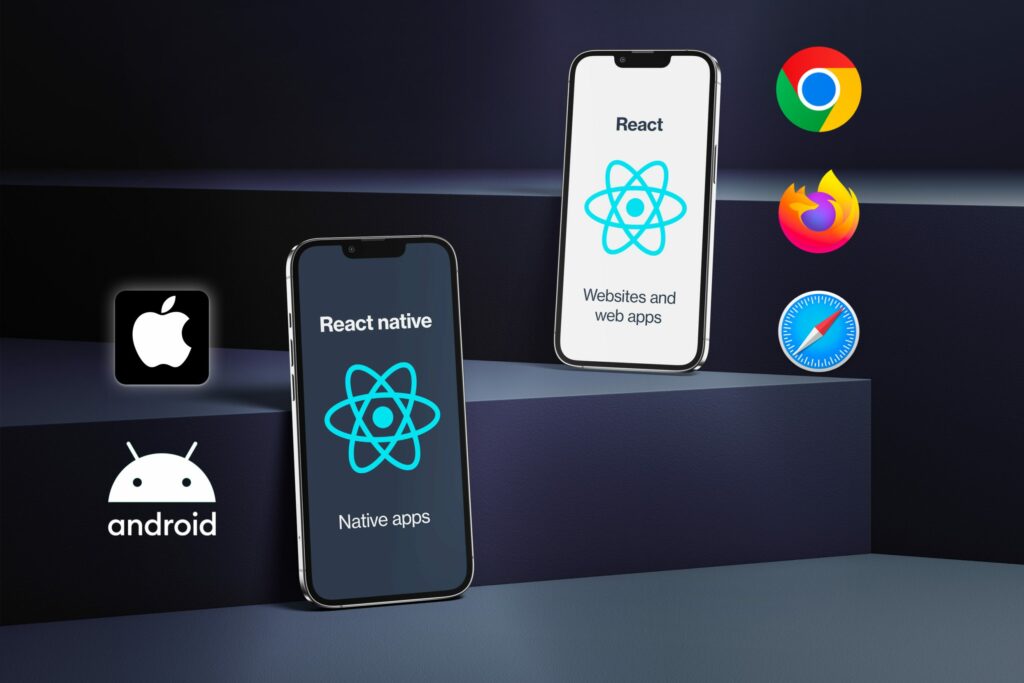You might’ve heard these names tossed around in tech meetups or seen them pop up in your X (Twitter) feed. They sound similar, but they actually have two distinct uses. Let’s clear the fog. React is your go-to for crafting beautiful, interactive web applications. It’s web-based, thriving in browsers and bringing websites to life with its dynamic user interfaces.
React Native, on the other hand, is used for developing mobile apps – hence the ‘native (apps)’ suffix. It extends React’s principles into the mobile framework, allowing developers to build apps for iOS and Android that feel truly native. The nuance lies in their domain of expertise – React’s prowess shines on the web, while React Native takes that expertise into the hands of mobile users. Understanding these differences is crucial, as it’s not just about choosing a technology, but picking the right tool for your project’s purpose, whether it’s a sleek website or an engaging mobile app.
History of React and React Native
Back in 2013, the brilliant minds at Facebook (now Meta) introduced us to React. It was like a breath of fresh air in the web development community. React made building dynamic, high-performing user interfaces simple. It also laid the foundation for React Native, its mobile counterpart, making it possible to create native-style apps for iOS and Android without learning Swift or Kotlin from scratch. Talk about a game-changer.

React works for both web and native technologies, such as Apple’s iOS and Android.
Who created React?
React was born at Facebook, thanks to their developers who were looking for a more efficient way to build user interfaces. It quickly went from an internal tool to an open-source project, inviting a global community of developers to play and improve it.
Why was React created?
Picture this: Facebook’s UI was getting complex and traditional methods just weren’t cutting it. They needed something that could handle dynamic content updates smoothly. Enter React, solving the issue with its innovative approach to rendering user interfaces.
What is ReactJS?
ReactJS is the Picasso of JavaScript libraries for building web interfaces. It’s got a Virtual DOM that makes updating your web app swift and straightforward. But it’s not all sunshine and rainbows – ReactJS has a bit of a learning curve, relies on external libraries, has a lack of proper documentation and has high overhead costs compared to Reach Native. Keeping up with its rapid evolution could feel like chasing your tail too.
UI focused
When it comes to crafting user interfaces (UI), React Native and ReactJS each play a distinct, yet crucial role. ReactJS is the architect of the web, designing UIs that are responsive, dynamic and engaging for web applications.
However, when the spotlight turns to mobile apps, React Native takes centre stage. It’s tailored specifically for mobile UIs, offering a more native-like user experience that aligns seamlessly with mobile operating systems. The real charm of React Native lies in its rich arsenal of component libraries and UI toolkits, which developers can use to build intuitive and visually appealing interfaces for iOS and Android apps. These tools not only enhance the UI but also streamline the development process, making React Native a powerful ally in the mobile app development arena.
Javascript
JavaScript, the heart of React, is the Swiss Army knife of programming languages. It’s essential for web development, working alongside core technologies HTML and CSS to bring web pages to life, infusing them with interactivity and functionality that HTML and CSS alone can’t achieve. Its versatility allows it to manipulate webpage elements, respond to user actions and even control multimedia – shaping the overall behaviour and user experience of websites and web apps.
JavaScript’s ubiquity and adaptability have made it an indispensable tool in any web developer’s toolkit. In the context of React, JavaScript acts as the backbone, enabling React to build dynamic and responsive user interfaces with efficiency and ease. This powerful synergy of JavaScript with React has redefined expectations for modern web applications, making them more interactive, responsive and user-friendly.
JSX
JSX, which stands for JavaScript XML, is a unique template syntax that truly sets React apart in the world of UI development. It’s like a bridge between the logic of JavaScript and the layout of HTML, but with a twist. In React, JSX allows developers to write their UI code in a way that closely resembles HTML, but with the full power of JavaScript. This fusion makes building React applications not only faster but also more intuitive.
Imagine being able to declare your UI elements right within your JavaScript code – that’s JSX for you. It streamlines the process of creating interactive user interfaces by seamlessly integrating markup with JavaScript logic. This innovative approach simplifies the development process, making it more efficient and accessible, especially for those transitioning from a traditional web development background. With JSX, React transforms the complex orchestration of user interfaces into a more harmonious and straightforward composition.
State management
State management, within the context of React, is like the art of orchestrating a symphony of data. It revolves around how a React app stores, accesses and manipulates data that’s crucial for its functionality. In React, think of state as the heartbeat, reflecting the app’s current condition or ‘state’ at any given moment – this could be anything from a user’s input to the status of a network request.
React particularly shines with its handling of local state, which is data managed within individual components, like a form input retaining its value. But React apps often need more. Enter global state – this is where data is shared across the entire application, like a user’s authentication status. React developers commonly employ tools like Context API or Redux to manage this global state efficiently. Then there’s external storage – databases and the like – where data exists outside the React app but is essential for functionalities such as persisting user data or settings. React interfaces with these external systems to provide a holistic and responsive user experience.
Advantages of React for web development
From its Virtual DOM offering unparalleled performance to its component-based architecture that paves the way for reusable and maintainable code, React has a plethora of advantages that make it a top choice for web development.
Whether you’re crafting a small interactive component or an expansive, data-driven web app, React equips developers with the tools to build fast, scalable and user-friendly web experiences. Let’s dive into the myriad of benefits that React brings to the table for digital product development.
React’s Virtual DOM is faster
React’s claim to fame in the web development world largely hinges on its innovative use of the Virtual DOM, a game-changer in how web applications render changes. Traditional web applications often rely on the full refresh model, where any small change in the user interface leads to a complete reload of the page. This can be slow and inefficient, especially with complex applications.
React flips the script with its Virtual DOM. Think of it as a lightweight copy of the actual DOM. When changes occur, React first updates this Virtual DOM. Then, the magic happens: React intelligently compares the updated Virtual DOM with the actual DOM, pinpointing the exact changes. Instead of reloading the whole page, React refreshes only those parts that have changed. This selective updating drastically enhances performance, making web applications snappier, more responsive and ultimately providing a smoother user experience. In a digital world where speed and efficiency are king, React’s approach to DOM manipulation stands out, making it a powerhouse for faster, more efficient web programming.
Time-saving code reuse
One of the most significant time-saving features of ReactJS is its emphasis on reusable components, a concept that has transformed the efficiency of web development. In React, components are essentially building blocks of the UI, modular pieces that can be used and reused across different parts of an application. Imagine having a set of Lego bricks – each component is like a brick that can be combined in various ways to build multiple UI instances.
This approach to code reuse comes with a plethora of benefits. Firstly, it drastically reduces code duplication. Instead of writing new code for similar UI elements, developers can repurpose existing components, leading to a more streamlined code base. This not only speeds up the development process but also makes the code easier to. By reusing components, developers can ensure consistency in the UI, which enhances the user experience. I also simplifies the testing process and makes the overall codebase more maintainable.
React is SEO friendly
React’s prowess in the world of web development isn’t limited to just building interactive UIs, it also extends to enhancing SEO – a critical aspect for any website’s success. Traditionally, JavaScript-heavy applications like those built with React have faced challenges with search engines. React tackles this with pre-rendering and server-side rendering techniques. Pre-rendering allows React to generate a cached static HTML version of a webpage, making it more digestible for search bots. This method bridges the gap between dynamic JavaScript content and the static HTML content that search engines love.
Server-side rendering, on the other hand, speeds up the process of indexing and caching by search engines. It ensures that the server sends a fully rendered page to the browser, significantly reducing the page load time, which is a key factor in SEO ranking. The advantages of using React for SEO are huge. By improving the indexing of web pages, React boosts the chances of higher organic traffic.
Speedier debugging
Debugging can often feel like navigating a complex maze, but ReactJS is like a GPS that leads you straight to the problem. ReactJS streamlines the debugging process, significantly reducing the time and effort needed to identify and resolve issues. It’s adept at tackling a variety of bugs that are common in web development, from user interface glitches to deeper logic errors and even tricky networking issues.
For instance, when a UI element isn’t behaving as expected, React’s component-based structure allows developers to isolate and test individual components easily. Logic errors, often a result of complex state management, become more manageable due to React’s clear and predictable flow of data. Networking bugs, like API call failures, are also easier to trace and fix because of how React interacts with data sources. Even when dealing with regressions, React’s robust ecosystem offers tools like Jest for snapshot testing, ensuring that new changes don’t break existing functionality. This turns what used to be a headache into something manageable.
Easily readable
React’s code is designed for optimal readability and maintainability, akin to a well-structured book. Its declarative nature and component-based organisation simplify understanding and following the UI’s logic, like reading individual chapters of a story.
JSX further enhances this by merging JavaScript with HTML-like syntax, making the connection between UI appearance and functionality clear. This organised approach not only makes code easy to review but also reduces errors, streamlining the development process and allowing developers to focus more on innovation than deciphering code.
The benefits of Javascript
JavaScript’s benefits for React development are manifold, thanks to its continuous evolution and robust ecosystem. As the scripting language of the web, JavaScript’s versatility and ubiquity have been significantly bolstered by advancements like ES6 and beyond, offering enhanced syntax, arrow functions, classes and more, which have streamlined the coding process. These advancements play a crucial role in React development, where JavaScript’s dynamic nature allows for the creation of interactive and responsive user interfaces. JavaScript’s vast ecosystem, brimming with libraries and frameworks, provides React developers with an array of tools and resources, further simplifying the development process.
In the realm of React Native, JavaScript’s advantages are even more pronounced. It enables developers to write mobile applications in a language they’re already familiar with, bypassing the need to learn new, platform-specific programming languages. This makes for a quicker development cycle and easier cross-platform compatibility, making React Native an efficient solution for innovative mobile app development.
Who uses React
ReactJS, the brainchild of Facebook, has become a cornerstone in their web development strategy. It’s extensively used by Facebook and Instagram, two of the most prominent Meta companies, to handle the myriad of dynamic user interfaces and API requests that define their platforms. At Facebook, ReactJS plays a pivotal role in rendering the complex, data-driven UIs, contributing to the seamless user experience that billions have come to rely on daily. Similarly, Instagram leverages ReactJS to manage its interactive features, like real-time updates and notifications, ensuring a smooth and responsive interface.
The adoption of ReactJS by these tech giants is a testament to its robustness, efficiency and scalability, especially in handling the vast amounts of data and the complex interactions inherent in these social media platforms. ReactJS’s ability to meet the high-performance demands of these Meta companies underscores its capability as a top-tier tool for building and maintaining large-scale, dynamic web applications.
What is React Native?
React Native, introduced by Facebook in 2015, has swiftly risen as a linchpin in the world of cross-platform mobile app development. This innovative framework empowers developers to build mobile applications for both Android and iOS platforms using a single codebase, drastically streamlining the development process. React Native blends the best of both worlds, leveraging the power of React along with native platform capabilities, to create “almost native” applications. It uses native components, allowing the apps to maintain the look, feel and performance of native applications while benefiting from the efficiency and simplicity of using a unified codebase.
This breakthrough in mobile development has made React Native a go-to choice for developers looking to efficiently create high-quality, platform-consistent mobile experiences.
Open source
React Native being open source is like having an all-access pass to an amusement park. You get free access to the code, a vibrant community to mingle with and a continuously evolving platform.
Developers have free access to its expansive codebase, allowing for a deeper understanding and customisation of their mobile applications. This accessibility fosters a vibrant developer community, a melting pot of ideas, innovations and solutions. This community is not just about collaboration; it’s a hub for mutual support, with easier availability of help and resources, making problem-solving faster and more efficient. Constant development is another hallmark of this open-source environment. React Native benefits from contributions from developers around the world, ensuring the framework stays at the forefront of technology. Its flexibility allows developers to adapt and integrate it according to diverse project requirements.
All these factors combined make React Native not just a tool for building mobile applications, but a constantly improving ecosystem that nurtures innovation and efficiency.
Cross-platform
React Native’s cross-platform superpower means you can build apps for different devices without learning new languages. It’s about writing once and charming both Android and iOS users.
This capability stands out as one of React Native’s most significant benefits, revolutionising the way apps are built for iOS, Android and desktop platforms, using only a single codebase that works seamlessly across multiple platforms, significantly reducing development time and cutting down costs. This unified codebase approach doesn’t just streamline the development process; it also ensures consistency in the user experience across different devices.
Advantages of React Native for mobile development
React Native has rapidly become a frontrunner in mobile development, offering a unique blend of efficiency and performance. It has a suite of advantages that make it an attractive option for building mobile applications.
Native UI
React Native takes a distinctive approach to UI rendering. Unlike ReactJS, which uses a virtual DOM to render browser code, React Native interacts directly with native APIs to render components for mobile. This means that the UI components in a React Native app are actual native components, providing the look, feel and performance of a native mobile application. This native rendering ensures that the user experience is as smooth and seamless as any app built using native tools.
Android and iOS from a single code base
One of the most compelling features of React Native is its ability to unify the development for both Android and iOS platforms using a single codebase. This common logic layer drastically reduces development time and effort. React Native employs the same fundamental UI building blocks as native Android and iOS applications, but these blocks are assembled using React and JavaScript. This approach not only simplifies the development process but also ensures consistency across different platforms.
Quick and cost effective
React Native’s single codebase approach leads to lower development costs and a faster route to market. Developers can rapidly prototype and test ideas, reducing the time from concept to launch. If you’re a startup or more established company looking to quickly adapt to market changes, React Native could be the mobile app framework for you.
Agile development
React Native aligns well with the principles and practices of Agile development methodology. Its modular and iterative nature fits perfectly with Agile’s emphasis on incremental, flexible and collaborative development. This synergy allows teams to adapt quickly to changes, continually test and deliver functional bits of the application throughout the development process.
Easy to use
For front-end web developers familiar with React, the transition to React Native is relatively smooth, thanks to the shared use of JavaScript and similar design principles. This minimal learning curve makes React Native an accessible and straightforward option for building mobile apps.
Platform-specific code
React Native smartly eliminates the need for platform-specific code for most of the app’s functionality, but it does offer the flexibility to write platform-specific code if needed. You can do this via platform-specific extensions and the Platform module, which allows developers to optimise an app for different platforms without compromising the shared codebase.
Hot reloading feature
One of the standout features of React Native is Hot Reloading, which significantly speeds up development. This feature allows developers to instantly see the result of the latest change without having to reload the entire app. This on-the-fly update capability streamlines the development process, making it faster and more efficient to iterate and refine the app.
Who uses React Native?
Companies big and small have jumped on the React Native bandwagon. With Facebook’s backing and its open-source nature, it’s become a go-to for mobile app development. In fact, the Stack Overflow Developer Survey stated that React Native was the sixth most popular cross-platform mobile framework in 2022.
Facebook itself, the birthplace of React Native, uses it extensively in its own mobile applications, showcasing the framework’s capabilities and reliability. Other notable examples include Airbnb, which utilises React Native to streamline its mobile app development and UberEats, where React Native played a pivotal role in improving the app’s user interface and performance. Instagram, another major player under the Meta umbrella, uses React Native to seamlessly integrate new features into the existing app. Bloomberg’s mobile application also benefits from React Native’s features, providing a more interactive and personalised user experience.
React vs React Native: The key differences
React Native is not just React for mobile; it’s a whole different beast. As a framework, it keeps updating and evolving, supported by a global community. It’s a multi-faceted tool for cross-platform development, offering cost efficiency and a faster route to market.
Framework
The React Native framework’s ability to share code across iOS and Android platforms is a game-changer, significantly streamlining the development process. This shared codebase not only ensures consistency in the user experience across different devices but also contributes to cost efficiency and faster development, particularly beneficial for MVPs (Minimum Viable Products).
Another key advantage of React Native is its continuous updates and active support from a global community. This ongoing development keeps the technology at the cutting edge, ensuring it remains relevant and effective in the rapidly evolving mobile app landscape. React Native’s blend of flexibility, efficiency and community-driven innovation makes it an appealing choice for businesses looking to capitalise on the power of mobile tech.
Rendering
ReactJS and React Native diverge significantly in their rendering approaches. ReactJS uses a virtual DOM to render browser code, providing a lightweight and efficient way to update the user interface. This virtual DOM compares the current state of the UI with new updates and efficiently changes only what’s necessary.
In contrast, React Native eschews the virtual DOM in favour of native APIs to render mobile components. This difference means that while ReactJS relies on traditional web technologies like HTML and CSS for rendering, React Native translates your JSX into native views, providing a more native-like experience on mobile devices. The distinction in rendering technologies underscores the unique approaches each framework takes to cater to their respective platforms – web for ReactJS and mobile for React Native.
UI components
The UI components in ReactJS and React Native are designed to serve their respective environments – web and mobile – with distinct rendering techniques. In ReactJS, components render as HTML using JSX, which allows developers to write their UI in a way that resembles HTML markup. This approach is intuitive for those familiar with web development. React Native, on the other hand, also uses JSX but translates this into native components specific to iOS or Android, rather than HTML. This means that while the syntax may be similar, the actual output is tailored to fit the native mobile environment, offering a more authentic mobile user experience.
Styling
Styling in ReactJS and React Native follows different paradigms suited to their platforms. In ReactJS, styling is typically handled using CSS, giving developers access to a familiar and powerful stylesheet language. React Native, however, uses a stylesheet abstraction that resembles CSS but is actually a JavaScript object.
This approach, powered by the Yoga layout engine, relies mainly on Flexbox for positioning and layout, along with absolute and relative positioning. This distinction in styling methods highlights the adaptations React Native makes to align with mobile development norms, offering a styling system that is both powerful and mobile-optimised.
Animation
When it comes to animation, ReactJS and React Native each play their own tune. In the world of ReactJS, creating animations is achieved with CSS transitions and keyframe animations. These are the go-to tools for web developers and they get the job done with a familiar ease, but they are not directly applicable in React Native.
Instead, React Native calls for extra help, from the Animated API or various third-party libraries, to get animations rolling. This switch-up between ReactJS and React Native might keep designers and developers on their toes, as they juggle different tools and techniques for each platform. This is indicative of the distinct nature of web versus mobile development, with each environment necessitating different approaches to animation.
ReactJS and React Native: Conclusion
So, there you have it! React and React Native – similar in name, but each with its own exclusive powers. Whether you’re building for the web with ReactJS or going mobile with React Native, both bring efficiency, speed and a touch of magic to the development process. Choose your hero wisely based on your project’s needs and embark on a tech adventure that’s both exciting and rewarding.
Table of contents



